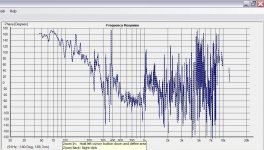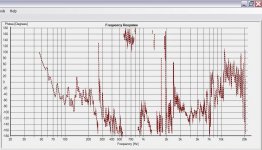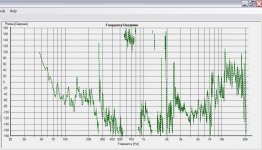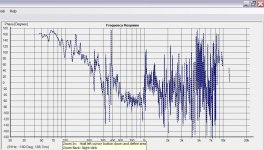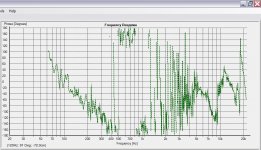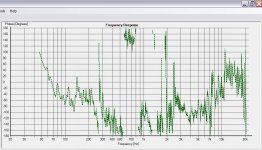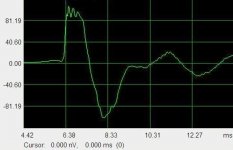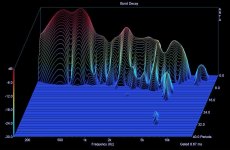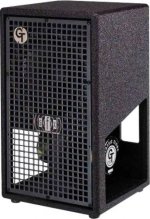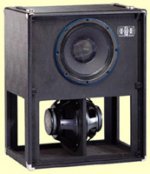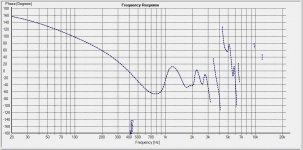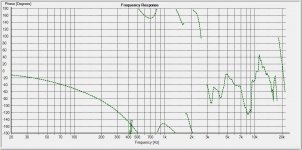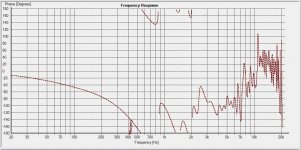SSS x = 0.5 Gerzonic psychoacoustic filter.
There was a question regarding the function of the filter:
I found suitable values for Csp = 4.7uF and Rsp = 4.7 ohm with Visaton FRS8 elements. Other elements may require different values.
The filter has two purposes:
1) To steer the high frequency energy from the center element to the side elements. This help preventing localisation of the speaker.
2) To steer the high frequency energy from the non panned side to the panned side. This helps creating stronger side signal from the 'correct' side.
In the following plots is demonstrated the response curves of each individual elements (idealised).
For a center panned signal i.e. L = 0.7 and R = 0.7 the element responses are: (note: curves for Lo and Ro coincide). It is seen that center element signal Co is low pass shelved, and side element signals Lo and Ro are high pass shelved.
For a hard left panned signal i.e. L = 1 and R = 0 the element responses are here: (note: now the curves for Co and Ro coincide). Now center element signal Co and right element signal is low pass shelved, and left element signal Lo is high pass shelved.
The simulation schema as FYI: I'm using APLAC, the best engineering tool ever
- Elias
There was a question regarding the function of the filter:
An externally hosted image should be here but it was not working when we last tested it.
I found suitable values for Csp = 4.7uF and Rsp = 4.7 ohm with Visaton FRS8 elements. Other elements may require different values.
The filter has two purposes:
1) To steer the high frequency energy from the center element to the side elements. This help preventing localisation of the speaker.
2) To steer the high frequency energy from the non panned side to the panned side. This helps creating stronger side signal from the 'correct' side.
In the following plots is demonstrated the response curves of each individual elements (idealised).
For a center panned signal i.e. L = 0.7 and R = 0.7 the element responses are: (note: curves for Lo and Ro coincide). It is seen that center element signal Co is low pass shelved, and side element signals Lo and Ro are high pass shelved.
An externally hosted image should be here but it was not working when we last tested it.
For a hard left panned signal i.e. L = 1 and R = 0 the element responses are here: (note: now the curves for Co and Ro coincide). Now center element signal Co and right element signal is low pass shelved, and left element signal Lo is high pass shelved.
An externally hosted image should be here but it was not working when we last tested it.
The simulation schema as FYI: I'm using APLAC, the best engineering tool ever
An externally hosted image should be here but it was not working when we last tested it.
- Elias
...
I want to see DIY BWL, with a proven measurements achieving the claimed 'decorrelation' !
...
Pity, no measurement to prove anything.
The character of chaotic vibration on large area (break-up all the time) makes it difficult or nearly impossible to make proper and meaningful measurements by ordinary methods. Many have tried and reported the very poor connection with hearing in person. I'm not any better than they are in this regard so I don't bother trying.
But OTOH, we have ears and brains. The combination is the ultimate target to fool anyway. Er, I mean, to persuade.
OK, if we want to measure "naturalness" of principal left/right and center
phantoms, why not simply measure anechoic FR at some defined positions
(listening in median plane vs. offset) with mono signal:
Full left panning, full right panning, centered.
Maybe a somewhat downsized stereo triangle
(and closer listening position) would be advantageous to
keep the room out above above say 300...500 Hz ?
So if we could agree on some configuration, we would have comparable
results in measuring "alternative" stereo setups.
phantoms, why not simply measure anechoic FR at some defined positions
(listening in median plane vs. offset) with mono signal:
Full left panning, full right panning, centered.
Maybe a somewhat downsized stereo triangle
(and closer listening position) would be advantageous to
keep the room out above above say 300...500 Hz ?
So if we could agree on some configuration, we would have comparable
results in measuring "alternative" stereo setups.
Last edited:
...
I want to see DIY BWL, with a proven measurements achieving the claimed 'decorrelation' !
...
- Elias
These raw phase plots (ungated) are from measurements i took about 2 years ago.
3 very different speakers in the same room, mic distance about 1m+ , but positions
of speakers are NOT the same, though comparable (no close side walls,
>1m distance from front wall ...)
"bwl" is an early "ancestor" of current "Model 2" bending wave loudspeaker
"d8" is "dipol08" line array
"rib" is a bookshelf speaker on a stand, having an isodynamic ("ribbon like") tweeter with XO somewhat below 1Khz
The upper cuttof of that early BWL was about 8Khz, so the phase plot is truncated
at the upper end when compared to the other speakers.
The bwl shows an increasing phase decorrelation >1Khz. The other speakers do not show this
behaviour consequently when looking at >2Khz.
Of course here we have all mixed up: Phase decorrelation from the speaker itself plus room effects,
also arising from different directivity of the speakers.
Nevertheless the isodynamic tweeter of the bookshelf speaker is very wide radiating in the horizontal
plane, because its membrane is only about 10mm wide X 120mm in height, no waveguide or protruding
edges on the baffle ... In comparison Dipol 08 is the most directional design of the three.
Subjective descriprion due to imageing and "disappearance":
The bookshelf speaker disappears with appropriate recordings, in the way any
good bookshelf speaker does it ... but with critical material (bad recordings e.g.)
it is localizeable as a sound source.
Dipol 08 is less localizeable, but with some recordings that have deficient spatial
cues you can't deny there are two "speaker clouds", which remind you sitting in
front of a loudspeaker, especially if you have speakers for comparison which are
"better" due to that respect:
The bending wave speaker (about 0.5 sqm planar design) disappears very well,
produces more depth in soundstage which depends on the recording and less on how
close you sit to the speakers. It has believable and stable center images even when
listening offset to the median plane. And no, it does not have that smeared
imaging that comes with many bending wave designs. Phase is comparably or even more
stable than in the 2 other designs below 1Khz, as you may notice.
The bwl is simply the most accurate or at least "believable" speaker of that 3 especially
regarding imaging.
But can you localize the tweeters ?
Which tweeters ... they are not there, you cannot even localize them
sharply with hard panned test clicks. Which is why i can imagine, you would like it too.
Attachments
Last edited:
OK, if we want to measure "naturalness" of principal left/right and center
phantoms, why not simply measure anechoic FR at some defined positions
(listening in median plane vs. offset) with mono signal:
Full left panning, full right panning, centered.
Maybe a somewhat downsized stereo triangle
(and closer listening position) would be advantageous to
keep the room out above above say 300...500 Hz ?
So if we could agree on some configuration, we would have comparable
results in measuring "alternative" stereo setups.
The principle of the SSS is to work in harmony with the listening room ! It does not work as intended without side wall reflections. How I should prove naturalness of the phantoms in anechoic conditions ?
- Elias
The bwl shows an increasing phase decorrelation >1Khz.
Is it able to reproduce an arbitrary high frequency waveform, or just an energy envelope with some time-freq resolution ?
- Elias
The principle of the SSS is to work in harmony with the listening room ! It does not work as intended without side wall reflections. How I should prove naturalness of the phantoms in anechoic conditions ?
- Elias
Yes i know, sorry that would only work comparing "triangular stereophonic"
configurations. What would you suggest ?
Is it able to reproduce an arbitrary high frequency waveform, or just an energy envelope with some time-freq resolution ?
- Elias
Pics below are not current "state of the art" and naturally a step response
e.g. looks a bit different depending on angle, but it produces waveforms
quite well.
In the current model i already approached that ringing around 5Khz and it
also has "fullrange response" to the upper end now.
It will take some weeks until there are new measurements, as i am
building a new listening room right now before christmas.
Attachments
ps. I'm going to try SSS on a sigle panel.
Brave decision
Which drivers would you be using ?
- Elias
The bwl shows an increasing phase decorrelation >1Khz.
I dont get it. If the phase is random how a specific waveform is reproduced ? Is the device linear, and falls into the class of LTI systems ?
Or, is it that the phase randomness in your plot is due to something else than pure driver, room reflections, diffraction etc ?
- Elias
As i said the phase plots above are "wet" plots, ungated.
They should only serve to show "inroom" behaviour of
(very) different speakers due to phase.
The step is nearfield about 50cm mic distance, the CSD
was with speaker standing on a carpeted bottom, mic distance ca. 1m.
They should only serve to show "inroom" behaviour of
(very) different speakers due to phase.
The step is nearfield about 50cm mic distance, the CSD
was with speaker standing on a carpeted bottom, mic distance ca. 1m.
... comparing ...
What would you suggest ?
I think everything relevant can be captured by binaural impulse response measured in the listening room speakers and listener at their intended positions.
I do realise that the interpretation of binaural IRs is pretty new branch of art, however, but is there any more 'natural' method ?
And, first of all, putting 'naturalness' into numbers is a challenge understadably.
Other option would be using field probe to capture the velocity and pressure components of the wave field at the listening position, scanned over a suitable space volume.
Of course non of these are 'trivial'.
- Elias
As i said the phase plots above are "wet" plots, ungated.
They should only serve to show "inroom" behaviour of
(very) different speakers due to phase.
The step is nearfield about 50cm mic distance, the CSD
was with speaker standing on a carpeted bottom, mic distance ca. 1m.
I see ! What a relief, I thought I would be lacking something
So then, the phase 'randomness' is due to a room, and similar high freq response could be achieved by e.g. a wide dispersion dome (0.5").
It appears to me that only benefit of BWL is much wider freq response compared to other 'coherent' wide dispersion radiators. That could be useful, sure.
- Elias
I'll post this just for fun !
Single speaker stereo is not only suitable for home, but it is used in PA as well.
Groove Tubes SFX:
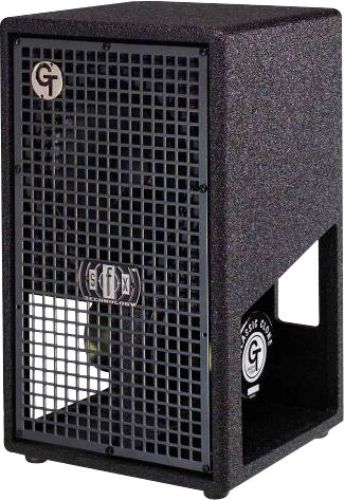
As functioning as a MS speaker, I could imagine the monopole gets the L+R and the dipole gets L-R, forming a radiation pattern of two sideways cardioids for stereo signals L and R. Looking at the dimensions it should work in the intended manner at least up to midrange.
More info:
http://www.groovetubes.com/assets/1650_SFX%20Op%20Manual%20-%208.5x11%20page.pdf
Another bigger one: Groove Tubes K5 SFX Stereo Decoder Speaker
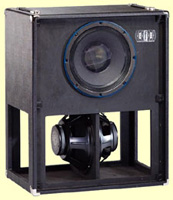
Direct firing 15" coaxial monopole and two 12" in face-to-face dipole for spatial symmetry.
Interesting
- Elias
Single speaker stereo is not only suitable for home, but it is used in PA as well.
Groove Tubes SFX:
As functioning as a MS speaker, I could imagine the monopole gets the L+R and the dipole gets L-R, forming a radiation pattern of two sideways cardioids for stereo signals L and R. Looking at the dimensions it should work in the intended manner at least up to midrange.
More info:
http://www.groovetubes.com/assets/1650_SFX%20Op%20Manual%20-%208.5x11%20page.pdf
Another bigger one: Groove Tubes K5 SFX Stereo Decoder Speaker
Direct firing 15" coaxial monopole and two 12" in face-to-face dipole for spatial symmetry.
Interesting
- Elias
Attachments
Last edited:
So then, the phase 'randomness' is due to a room, and similar high freq response could be achieved by e.g. a wide dispersion dome (0.5").
- Elias
That effective "inroom phase randomness" is due to a room AND the spatial
phase pattern the speaker exhibits. From the phase plot you cannot
recognize how the pattern changes with angle ... in fact it changes with
very very small angles towards higher frequencies but keeps up the "gross
statistical shape".
The narrow ribbon tweeter e.g. has wide dispersion but does not produce the same
"inroom decorrelation", neither would a dome tweeter be able to do that.
Below some gated versions. As before the bwl's phase changes in a more narrow
banded manner and also more and more excessively towards higher frequencies at
a certain point in space.
That is the input for the room to "do the rest" (of diffusion, like it does always) and
establish a resulting pattern which is very appropriate IMO due to our
"speaker localization vs. phantom imageing" problem. That problem largely has to do
with interchannel (left/right interspeaker) interference.
If you smooth the ungated phase plots, you will see that the average phase is quite
stable compared to the other speakers and also the bw loudspeaker has very flat
group delay.
It appears to me that only benefit of BWL is much wider freq response compared to other 'coherent' wide dispersion radiators. That could be useful, sure.
- Elias
Please see above, it is not just the wider dispersion.
BTW with that bwl my "RFZ believer" relativizes to some degree: A canny made bwl is sxtremely benign to early reflections,
as it produces mitigated interference with the (also more diffuse) mirror sources of itself.
Attachments
Last edited:
That effective "inroom phase randomness" is due to a room AND the spatial
phase pattern the speaker exhibits. From the phase plot you cannot
recognize how the pattern changes with angle ... in fact it changes with
very very small angles towards higher frequencies but keeps up the "gross
statistical shape".
Yes, I forgot that spatial randomness.
How small is "very very small" ?
It would be interesting to see phase vs mic lateral shift at some selected freqs in the near field of one such BWL. Is it neccessary to sample space in mm or in cm steps to not to alias the phase ?
The narrow ribbon tweeter e.g. has wide dispersion but does not produce that
"inroom decorrelation", neither would a dome tweeter be able to do that.
You maybe mean 'roomless decorrelation' ? Because in room there is decorrelation also from a normal dome due to multible reflection paths.

IDEA: By using an Bessel array (N*N) we could get wide dispersion AND some additional high freq spatial phase decorrelation due to 'spatially random' finite path length differences of, say, 3" drivers of the array !
I can imagine already SSS with 3*3 or 5*5 Bessel arrays on three sides of a box
- Elias
You maybe mean 'roomless decorrelation' ? Because in room there is decorrelation also from a normal dome due to multible reflection paths.
Elias
Yes of course,
or "the dome tweeter cannot produce the same amount of decorrelation
after same number of inroom reflections like a "canny" built bwl."
Yes of course,
or "the dome tweeter cannot produce the same amount of decorrelation
after same number of inroom reflections like a "canny" built bwl."
But in the case room is allowed to help in decorrelation, then it is possible to achieve low enough level of it with any tweeter for example by ceiling firing, or by using SSS.
The real question is: Is BWL able to decorrelate phase in spatial domain without room reflections in such amount that when listened at 2 m distance a 1 cm lateral shift will provide required level of decorrelation ?
Because only then conventional stereo field interference is to be avoided without the room support.
- Elias
But in the case room is allowed to help in decorrelation, then it is possible to achieve low enough level of it with any tweeter for example by ceiling firing, or by using SSS.
- Elias
IMO there's no difference in using the reflected sound from an irregular surface as direct sound or producing diffuse sound by
decorrelated sources in the first place. The difference is in the specific technical difficulties to be tackled.
In the reflection case: Ho to get reflected sound "dominant" over the portion reaching the listener directly or how to time align direct
and reflected components.
In case of BWL: At what frequency the decorrelation on spatial level should start and how fine the lobing should get
depending on frequency.
The real question is: Is BWL able to decorrelate phase in spatial domain without room reflections in such amount that when listened at 2 m distance a 1 cm lateral shift will provide required level of decorrelation ?
- Elias
So i find it hard to give exact measures for a "spatial decorrelation profile", because all this is a gradual thing.
My first goal in designing bwl was to modify (mitigate) audible (and detrimental non diffuse) speaker-room interaction.
And yes, the increased diffusivity in first room reflections, may even be the predominantly audible
effect more than "direct spatial decorrelation" given by the lobed radiation pattern of the transducer.
This is why i would like to measure the quality of center images, even for listening positions outside the
median plane.
Last edited:
- Home
- Loudspeakers
- Multi-Way
- Stereophonic Sound from a Single Loudspeaker
